Assault Amphibious Vehicle
The Assault Amphibious Vehicle[2][3] (AAV)—official designation AAVP-7A1 (formerly known as Landing Vehicle, Tracked, Personnel-7 abbr. LVTP-7)—is a fully tracked amphibious landing vehicle manufactured by U.S. Combat Systems (previously by United Defense, a former division of FMC Corporation).[4][5]
| AAVP7A1 RAM/RS | |
|---|---|
.jpg) An Assault Amphibious Vehicle of the U.S. Marines, assigned to the 1st Battalion, 23rd Infantry Convoy, conduct a simulated amphibious assault during exercise BALTOPS 2017, Latvia | |
| Type | Amphibious armored personnel carrier |
| Place of origin | United States |
| Service history | |
| In service | 1972–present |
| Used by | See Operators |
| Wars | Falklands War Lebanese Civil War Invasion of Grenada Persian Gulf War Somali Civil War Iraq War |
| Production history | |
| Designer | FMC Corporation |
| Manufacturer | United Defense |
| Produced | 1972 |
| Specifications | |
| Mass | 29.1 t (64,000 lb) |
| Length | 7.94 m (321.3") |
| Width | 3.27 m (128.72") |
| Height | 3.26 m (130.5") |
| Crew | 3+21 |
| Armor | 45 mm (1.8 in) |
Main armament | Mk 19 40 mm automatic grenade launcher (rounds: 96 ready; 768 stowed) or 12.7 mm M85 heavy machine gun |
Secondary armament | M2HB .50-caliber (12.7 mm) machine gun (rounds: 200 ready; 1,000 stowed) |
| Engine | Detroit Diesel 8V-53T (P-7), Cummins VTA-525 /903 cubic inches (P-7A1) 400 hp (300 kW) VTAC 525 903 525 hp (AAV-7RAM-RS) |
| Power/weight | 18 hp/ton |
| Suspension | torsion-bar-in-tube (AAV-7A1); torsion bar (AAV-7RAM-RS) |
Operational range | 480 km (300 miles); 20 NM in water, including survival in Sea State 5 |
| Maximum speed | 24–32 km/h (15–20 mph) off-road, 72 km/h (45 mph) surfaced road, 13.2 km/h (8.2 mph) water[1] |
The AAV-P7/A1 is the current amphibious troop transport of the United States Marine Corps. It is used by U.S. Marine Corps Assault Amphibian Battalions to land the surface assault elements of the landing force and their equipment in a single lift from assault shipping during amphibious operations to inland objectives and to conduct mechanized operations and related combat support in subsequent mechanized operations ashore. It is also operated by other forces. Marines call them "amtracs", a shortening of their original designation, "amphibious tractor".
In June 2018, the Marine Corps announced they had selected the BAE Systems/Iveco wheeled SuperAV for the Amphibious Combat Vehicle (ACV) program to supplement and ultimately replace the AAV.
History
Development
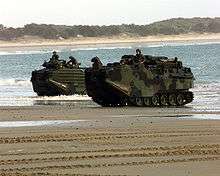
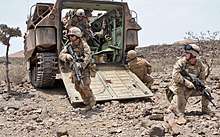
The LVTP-7 was first introduced in 1972 as a replacement for the LVTP-5. In 1982, FMC was contracted to conduct the LVTP-7 Service Life Extension Program (SLEP), which converted the LVT-7 vehicles to the improved AAV-7A1 vehicle by adding an improved engine, transmission, and weapons system and improving the overall maintainability of the vehicle. The Cummins VT400 diesel engine replaced the GM 8V53T, and this was driven through FMC's HS-400-3A1 transmission. The hydraulic traverse and elevation of the weapon station was replaced by electric motors, which eliminated the danger from hydraulic fluid fires. The suspension and shock absorbers were strengthened as well. The fuel tank was made safer, and a fuel-burning smoke generator system was added. Eight smoke grenade launchers were also placed around the armament station. The headlight clusters were housed in a square recess instead of the earlier round type. The driver was provided with an improved instrument panel and a night vision device, and a new ventilation system was installed. These upgraded vehicles were originally called LVT-7A1, but the Marine Corps renamed the LVTP-7A1 to AAV-7A1 in 1984.
Another improvement was added starting in 1987 in the form of a Cadillac Gage weapon station or Up-Gunned Weapon Station (UGWS) which was armed with both a .50 cal (12.7 mm) M2HB machine gun and a Mk-19 40 mm grenade launcher.
Enhanced Applique Armor Kits (EAAK) were developed for the AAV-7A1 in 1989 and fitted by 1993, and the added weight of the new armor necessitated the addition of a bow plane kit when operating afloat.
The Assault Amphibian Vehicle Reliability, Availability, Maintainability/Rebuild to Standard (AAV RAM/RS) Program was approved in 1997. It encompassed all AAV systems and components to return the AAV to the original vehicle's performance specifications and ensure acceptable readiness until the EFV should become operational. The program replaced both the AAV engine and suspension with US Army M2 Bradley Fighting Vehicle (BFV) components modified for the AAV. Ground clearance returned to 16 inches (40.6 cm) and the horsepower to ton ratio increased from 13 to 1 to its original 17 to 1. The introduction of the BFV components and the rebuild to standard effort was expected to reduce maintenance costs for the expected remaining life of the AAV through the year 2013.
In March 2015, SAIC was awarded a contract to perform an AAV Survivability Upgrade (SU).[6] Marine Corps and SAIC officials unveiled the AAV SU prototype in January 2016, with survivability enhancements including replacing the angled EAAK with 49 advanced buoyant ceramic armor panels, a bonded spall liner, armor-protected external fuel tanks, an aluminum armor underbelly providing Mine Resistant Ambush Protected (MRAP)-equivalent blast protection, and blast mitigating seats as well as a more powerful engine, new suspension system, and increased reserve buoyancy.[7][8][9] The AAV SU program was intended to upgrade 392 out of the some 1,000-vehicle fleet to keep them operational through 2035 as the ACV gradually entered service. However, in August 2018 the Marine Corps terminated the AAV upgrade program, instead opting for increased procurement of the ACV.[10][11]
Combat history
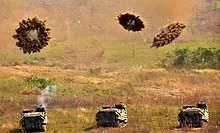
Twenty U.S.-built LVTP-7s were used by Argentina during the 1982 invasion of the Falkland Islands[12] with all of them returning to the Argentine mainland before the war ended. From 1982 to 1984, LVTP-7s were deployed with U.S. Marines as part of the multi-national peacekeeping force in Beirut, Lebanon. As Marines became increasingly involved in hostilities, several vehicles sustained minor damage from shrapnel and small arms fire. On October 25, 1983 U.S. Marine LVTP-7s conducted a highly successful amphibious landing on the island of Grenada as part of Operation Urgent Fury. It was heavily used in the 1991 Gulf War and Operation Restore Hope.
After the 2003 invasion of Iraq, AAV-7A1s were criticized for providing poor protection for the crew and passengers compared with other vehicles, such as the M2 Bradley. Eight were disabled or destroyed during the Battle of Nasiriyah, where they faced RPG, mortar, tank and artillery fire. At least one vehicle was destroyed by fire from friendly A-10 Warthog Close Air Support (CAS) aircraft.[13][14][15]
On 3 August 2005, 14 U.S. Marines and their Iraqi interpreter were killed when their AAV struck a roadside bomb in the city of Haditha in the Euphrates river valley in western Iraq..[7]
Eight U.S. Marines and one U.S. Navy sailor died on 30 July 2020, when their AAV sank in the Pacific Ocean off the coast of San Clemente Island, California, during a training exercise, ahead of an upcoming deployment.[16]
Replacement attempts
Cancelled: Expeditionary Fighting Vehicle
Renamed from the Advanced Assault Amphibious Vehicle in late 2003, the Expeditionary Fighting Vehicle (EFV) was designed to replace the ageing AAV. Able to transport a full Marine rifle squad to shore from an amphibious assault ship beyond the horizon with three times the speed in water and about twice the armor of the AAV, and superior firepower as well it was the Marine Corps' number one priority ground weapon system acquisition. The EFV was intended for deployment in 2015.[17] However, in January 2011, United States Defense Secretary Robert Gates announced plans to cancel the Expeditionary Fighting Vehicle. In 2012, the USMC dropped the EFV and cancelled the program.
Replacement: Amphibious Combat Vehicle
In June 2018, the Marine Corps announced they had selected the BAE Systems/Iveco wheeled SuperAV for the Amphibious Combat Vehicle (ACV) program to supplement and ultimately replace the AAV.[18][19]
Variants
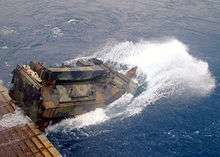
- LVTP-7: Original series introduced from 1972. Originally armed with a M85 12.7 mm (.50cal) machine gun.
- LVTP-7A1: 1982 upgraded. Renamed to AAVP-7A1 from 1984.
- AAVP-7A1 (Personnel): This is the most common AAV, as it carries a turret equipped with an M2HB .50 caliber heavy machine gun, and a Mk19 40mm automatic grenade launcher. It carries four crew radios as well as the AN/VIC-2 intercom system. It is capable of carrying 25 combat equipped Marines in addition to the crew of 4: driver, crew chief/vehicle commander, gunner, and rear crewman.
- AAVC-7A1 (Command): This vehicle does not have a turret, and much of the cargo space of the vehicle is occupied by communications equipment. This version only has two crew radios, and in addition to the VIC-2, it also carries two VRC-92s, a VRC-89, a PRC-103 UHF radio, a MRC-83 HF radio and the MSQ internetworking system used to control the various radios. This AAV has a crew of 3, and additionally carries 5 radio operators, 3 staff members, and 2 commanding officers. Recently, the C7 has been upgraded to use Harris Falcon II class radios, specifically the PRC-117 for VHF/UHF/SATCOM, and the PRC-150 for HF.
- AAVR-7A1 (Recovery): This vehicle also does not have a turret. The R7 is considered the "wrecker", as it has a crane as well as most tools and equipment needed for field repairs. It is by far the heaviest of the three, and sits considerably lower in the water. Crew of three, plus the repairmen.
Many P7s have been modified to carry the Mk 154 MCLC, or Mine Clearance Line Charge. The MCLC kit can fire three linear demolition charges to breach a lane through a minefield. MCLCs were used in the 1991 Persian Gulf War and again in Operation Iraqi Freedom in 2003.
In the 1970s, the US Army used an LVTP-7 as the basis for their Mobile Test Unit (MTU), a ground-based high-energy anti-aircraft laser. After several successful test firings at Redstone Army Arsenal, the laser was reportedly transferred to NASA.
- AAVP7A1 RAM/RS
- KAAV7A1: KAAV7A1 amphibious vehicle series based on AAV-7A1 by Samsung Techwin (now Hanwha Defense) and BAE systems developed and manufactured in South Korea by Samsung Techwin.[20]
Training systems
The Office of Naval Research (ONR) under the Virtual Training and Environments (VIRTE) program, led by then LCDR Dylan Schmorrow, developed a prototype training system called the AAV Turret Trainer. The system consists of an actual surplus turret mounted with ISMT (Indoor Simulated Marksmanship Trainer) weapons firing on a projected screen displaying the VIRTE Virtual Environment.[21] At total of 15 systems were produced for the USMC and one system for Taiwan.[22]
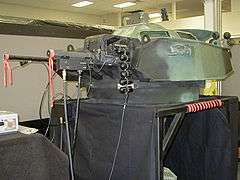 Early pre-production prototype of the AAV TT
Early pre-production prototype of the AAV TT.jpg) Well deck with AAVs
Well deck with AAVs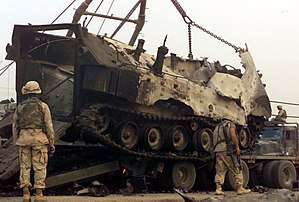 A USMC AAV destroyed near Nasiriyah in 2003
A USMC AAV destroyed near Nasiriyah in 2003- Spanish marines deploying from an AAV-7 during an exhibition in 2009
_deploy_smoke_to_cover_their_landing_during_a_simulated_amphibious_landing_demonstration.jpg) Landing force demonstration
Landing force demonstration.jpg)
Operators
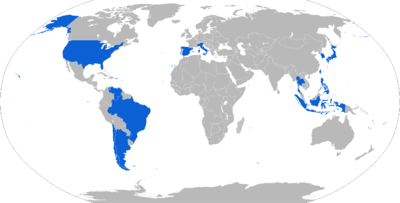
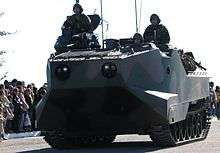











Notes
- Eland, Ivan, Putting "Defense" Back Into U.S. Defense Policy, Greenwood Publishing Group, 2001, p.150
- "LVTP-7 AAVP-7A1 AAV-7 amphibious assault armored vehicle data | United States American Army light armoured vehicle | United States US Army Military equipment UK". Archived from the original on 2019-03-21.
- "Assault Amphibious Vehicle Systems (AAVS)". Marine Corps Systems Command. 2009-03-19. Archived from the original on March 27, 2008. Retrieved 2010-08-04.
- "Archived copy". Archived from the original on 2015-09-24. Retrieved 2014-05-04.CS1 maint: archived copy as title (link)
- "Archived copy". Archived from the original on 2014-05-05. Retrieved 2014-05-04.CS1 maint: archived copy as title (link)
- SAIC Continues into Next Phase of Assault Amphibious Vehicle Survivability Upgrade Archived 2015-03-28 at the Wayback Machine - PRNewswire.com, 5 March 2015
- Marines' aging amphibious vehicle fleet to get better armor, more power Archived 2017-06-20 at the Wayback Machine - MarineCorpstimes.com, 29 January 2016
- US Marine Corps Shows Off Upgraded Amphib Vehicle - Marine Corps Times (16 March 2016)
- Marines’ Upgraded AAVs Begin Delivering, Will Comprise One-Third of Lift Need In 2020s Archived 2016-03-28 at the Wayback Machine - News.USNI.org, 23 March 2016
- USMC AAV7 Assault Amphibious Vehicle survivability upgrade program terminated Archived 2018-09-16 at the Wayback Machine. Army Recognition. 13 September 2018.
- Marine Corps Cancels AAV Survivability Upgrade Archived 2018-09-27 at the Wayback Machine. USNI News. 25 September 2018.
- Smith, Gordon (1989). Battles of the Falklands War. p. 21. ISBN 9780711017924.
- Deadliest battle of war so far Sarasota Herald-Tribune, from The New York Times News Service, March 24, 2003
- Zeigler, Martin (2006). Three Block War II: Snipers in the Sky. iUniverse, pp. 34 and 36.ISBN 0-595-38816-7
- Final Roll Call Archived May 8, 2005, at the Wayback Machine
- https://news.usni.org/2020/08/08/sailor-marines-remains-and-sunken-aav-recovered-off-san-clemente-island
- U.S. Marine EFV Delivery Delayed to 2015 and Costs Double. defensenews.com
- BAE wins Marine Corps contract to build new amphibious combat vehicle. Defense News. 19 June 2018.
- Marines Pick BAE to Build Amphibious Combat Vehicle; Contract Worth Up to $1.2B Archived 2018-06-21 at the Wayback Machine. USNI News. 19 June 2018.
- "Archived copy". Archived from the original on 2019-05-10. Retrieved 2019-05-11.CS1 maint: archived copy as title (link)
- "Virtual reality, real ingenuity". physorg.com. Archived from the original on 1 March 2012. Retrieved 19 February 2016.
- "TJ, Inc". Tjinc-eng.com. Archived from the original on 2015-03-08. Retrieved 2013-11-16.
- "Mecatrol". Mecatrol. Archived from the original on 2013-12-15. Retrieved 2013-11-16.
- "BAE Systems to Provide Assault Amphibious Vehicles to Brazilian Marine Corps". BAE Systems - United States. Archived from the original on 2017-07-30. Retrieved 2017-07-30.
- "Korsel Hibahkan 10 Tank Amfibi Buatan AS untuk RI". Kompas. 14 November 2009. Archived from the original on 17 November 2009. Retrieved 24 December 2014.
- Jr., Sydney J. Freedberg. "BAE Unveils 1st Amphibious Combat Vehicle For Marines". Archived from the original on 2017-07-30. Retrieved 2017-07-30.
- KALLENDER-UMEZU, PAUL (13 April 2014). "Big-Ticket Buys Could Hurt Japan". www.defensenews.com. Gannett Government Media. Retrieved 13 April 2014.
- SONODA, KOJI (21 August 2013). "Defense Ministry preparing Japanese version of U.S. Marines". asahi.com. The Asahi Shimbun Company. Archived from the original on 14 October 2013. Retrieved 9 October 2013.
- Wasserbly, Daniel (7 April 2016). "Japan buys new BAE Systems AAV7A1 amphibious assault vehicles". Jane's IHS 360. Washington, DC: Jane's IHS. Archived from the original on 11 April 2016. Retrieved 8 April 2016.
- BAE Systems to Provide Upgraded Amphibious Assault Craft to Japan Archived 2016-04-12 at the Wayback Machine - Defensetech.org, 8 April 2016
- "Obama's Plan to Arm Taiwan". warisboring.com. Archived from the original on 2015-12-22. Retrieved 2015-12-17.
- "Archived copy". Archived from the original on 2019-04-30. Retrieved 2019-04-30.CS1 maint: archived copy as title (link)
External links
| Wikimedia Commons has media related to Assault Amphibious Vehicle. |